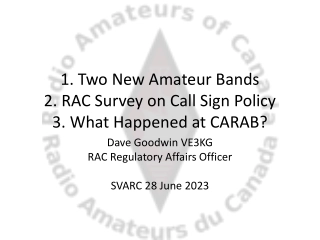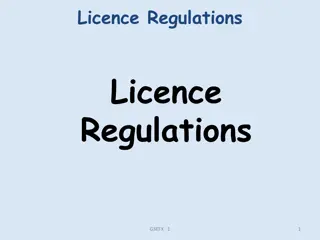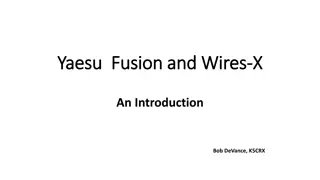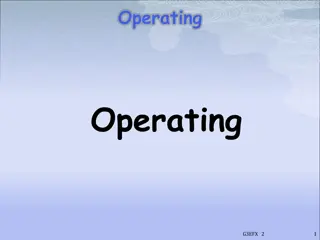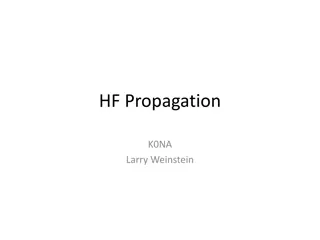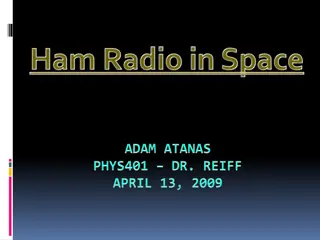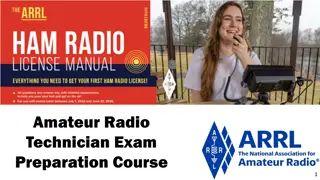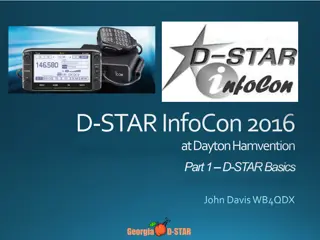Understanding Radio Communication Essentials for Amateur Radio Technician Exam
Dive into the fundamentals of radio communication for the Amateur Radio Technician Exam. Explore topics such as modulation, equipment, transmission, reception, and the art of adding and extracting information from radio waves. Gain insights into how information is converted, transmitted, and received in the world of ham radio. Prepare yourself with the basics and discover the fascinating world of radio communication.
Download Presentation

Please find below an Image/Link to download the presentation.
The content on the website is provided AS IS for your information and personal use only. It may not be sold, licensed, or shared on other websites without obtaining consent from the author. Download presentation by click this link. If you encounter any issues during the download, it is possible that the publisher has removed the file from their server.
E N D
Presentation Transcript
Amateur Radio Technician Exam Preparation Course 1
Amateur Radio Technician Exam Prep Course Module 5 Amateur Radio Equipment 5.1 Modulation 5.2 Transmitters and Receivers 5.3 Digital Communications 5.4 Power Supplies and Batteries 2 2
Modulation & Bandwidth Antenna The Basic Radio Station Feed line Transceiver TRANSMITTER TR SWITCH RECEIVER Review from previous module POWER SUPPLY 3 3
What Happens During Radio Communication? Transmitting (sending a signal) Information (voice, data, video, commands, etc.) is converted to electronic form The information in electronic form is added to a radio wave The radio wave carrying the information is sent from the station antenna into space 4 4
What Happens During Radio Communication? (cont.) Receiving The radio wave carrying the information is intercepted by the receiving station s antenna The receiver extracts the information from the received wave The information is then presented to the user in a format that can be understood (sound, picture, words on a computer screen, response to a command, etc.) 5 5
What Happens During Radio Communication? (cont.) Adding and extracting the information can be simple or complex This makes ham radio fun learning all about how radios work Don t be intimidated. You will be required to only know the basics, but you can learn as much about the art and science of radio as you want. 6 6
Adding Information Modulation When we add some information to the radio wave, (the carrier) we modulate the wave Turn the wave on and off (Morse code) Speech or music Data Different modulation techniques vary different properties of the wave to add the information: Amplitude, frequency, or phase A signal that doesn t carry any information is called unmodulated Recovering the information from a modulated signal is called demodulation 7 7
Continuous Wave (CW) The simplest type of modulation is a continuous wave turned ON and OFF in a coded pattern Morse code radio signals are called CW for that reason Figure 5.1 Information can be added to an RF signal by modulating the signal s amplitude. 8 8
Amplitude Modulation (AM) In AM, the amplitude of the carrier wave is modified in step with the waveform of the information (the tone shown here) The information is contained in the outline or envelope of the resulting signal Recovering speech or music from the envelope of an AM signal is called detection 9 9
Composite Signals Sidebands An actual AM signal is made up of three separate signals working together a carrier and two sidebands The carrier is a steady, unmodulated signal The upper sideband or USB signal is higher in frequency than the carrier The lower sideband or LSB signal is lower in frequency than the carrier 10 10
SINGLE-SIDEBAND (SSB) In an AM signal the carrier doesn t carry any information Each sideband contains a copy of the modulating signal Only one sideband is needed to transmit the information All of the SSB signal s power is concentrated in the one sideband SSB signals are effective for long-distance and weak signal voice contacts because of the additional power The upper sideband (USB) is used on VHF and UHF Both USB and LSB are used on the MF and HF bands 11 11
Frequency and Phase Modulation Modes that vary the frequency of a signal to add speech or data information are called frequency modulation or FM The frequency of an FM signal varies with the amplitude of the modulating signal Phase modulation varies a signal s phase instead of changing its frequency in other words, very similar to FM FM is the mode used by most VHF and UHF repeaters Because of the way FM receivers work, only one signal can be received at a time. This is called the capture effect and if multiple signals are present, only the strongest will be heard in the receiver. 12 12
Bandwidth of Modulated Signals A signal can have both a frequency and a strength or amplitude Signals are spread out over a range of frequencies (called bandwidth) You can communicate with SSB over much longer ranges and in poorer conditions than with FM or AM, particularly on the VHF and UHF bands For even better range, extremely narrow CW signals are the easiest for a human operator to send and receive, particularly in noisy or fading conditions CW and SSB are considered weak signal modes because they are more effective than FM at low signal strengths 13 13
Bandwidth of Modulated Signals (cont.) If an SSB signal can use either an upper or lower sideband which one should you use? Ham radio has standardized on the following conventions Below 10 MHz, LSB Above 10 MHz, USB including all of the VHF and UHF bands One exception: amateurs are required to use USB on the five channels of the 60 meter band (5 MHz) 14 14
What is CW? A. A type of electromagnetic propagation B. A digital mode used primarily on 2 meter FM C. A technique for coil winding D. Another name for a Morse code transmission T8D09 D 5-2 16 16
Which of the following is a form of amplitude modulation? A. Spread spectrum B. Packet radio C. Single sideband D. Phase shift keying (PSK) T8A01 C 5-3 17 17
What type of modulation is commonly used for VHF packet radio transmissions? A. FM or PM B. SSB C. AM D. PSK T8A02 A 5-4 18 18
Which type of modulation is commonly used for VHF and UHF voice repeaters? A. AM B. SSB C. PSK D. FM or PM T8A04 D 5-4 19 19
Which of the following is a disadvantage of FM compared with single sideband? A. Voice quality is poorer B. Only one signal can be received at a time C. FM signals are harder to tune D. All these choices are correct T8A12 B 5-4 20 20
Which type of voice mode is often used for long-distance (weak signal) contacts on the VHF and UHF bands? A. FM B. DRM C. SSB D. PM T8A03 C 5-4 21 21
Which of the following types of signal has the narrowest bandwidth? A. FM voice B. SSB voice C. CW D. Slow-scan TV T8A05 C 5-4 22 22
Which sideband is normally used for 10 meter HF, VHF, and UHF single-sideband communications? A. Upper sideband B. Lower sideband C. Suppressed sideband D. Inverted sideband T8A06 A 5-4 23 23
What is a characteristic of single sideband (SSB) compared to FM? A. SSB signals are easier to tune in correctly B. SSB signals are less susceptible to interference C. SSB signals have narrower bandwidth D. All these choices are correct T8A07 C 5-4 24 24
What is the approximate bandwidth of a typical single sideband (SSB) voice signal? A. 1 kHz B. 3 kHz C. 6 kHz D. 15 kHz T8A08 B 5-4 25 25
What is the approximate bandwidth of a VHF repeater FM voice signal? A. Less than 500 Hz B. About 150 kHz C. Between 10 and 15 kHz D. Between 50 and 125 kHz T8A09 C 5-4 26 26
What is the approximate bandwidth of AM fast-scan TV transmissions? A. More than 10 MHz B. About 6 MHz C. About 3 MHz D. About 1 MHz T8A10 B 5-4 27 27
What is the approximate bandwidth required to transmit a CW signal? A. 2.4 kHz B. 150 Hz C. 1000 Hz D. 15 kHz T8A11 B 5-4 28 28
Transmitters and Receivers Usually combined into one unit called a transceiver Give you control of frequency and mode Generalized categories Mobile Single band Dual band All band Multi-mode Handheld or HT 29 29
Single-Band Mobile Single-band, 2 meter good starter radio Operates from 13.8 volts DC, requires external power supply or car battery Requires an external antenna Can be operated mobile or as a base station Limited to frequency modulation (FM) and usually either 2 meters or 70 cm bands Up to approximately 50 watts output Typical frequencies: VHF/UHF FM 30 30
Dual-Band Mobile Same as the single-band transceiver but includes additional band(s) Most common are 2 meter and 70 cm bands Often includes 6 meters, 222 MHz (1.25 meters) or 1.2 GHz bands Might have separate antenna connections for each band or a single connection for a dual-band antenna Up to approximately 50 watts output Typical frequencies: VHF/UHF FM 31 31
Multimode Transceiver Nearly all HF rigs are multimode VHF multimode operates on FM plus AM/SSB/CW modes Required for weak-signal operation on VHF/UHF More features add complexity and cost More flexibility will allow you to explore new modes as you gain experience (and increased license privileges) 32 32
Multiband Transceiver Covers many bands usually refers to coverage of HF + VHF/UHF Also covers all modes Frequently 100 watts on HF, some power limitations on high bands (25-50 watts) Larger units have internal power supplies, smaller units need external power supply Some have built-in tuners 33 33
Handheld (HT) Transceiver Small handheld FM units Can be single band or dual band Limited power (usually 5 watts or less) Includes power (battery) and antenna in one package Often purchased as a starter rig but low power limits range Single, dual and multiband versions (with increasing cost and complexity) Some can receive outside the ham bands, such as aircraft, commercial FM broadcast, etc. 34 34
Handheld (HT) Transceiver (cont.) Very portable and self-contained Internal microphone and speaker Rubber duck antenna Battery powered Extra battery packs AA cell pack useful in emergencies Drop-in, fast charger Extended antenna External microphone and speaker Headset 35 35
Side-By-Side Comparison SINGLE BAND DUAL BAND MULTIMODE MULTIBAND HANDHELD FREQUENCY AGILITY LIMITED MEDIUM MEDIUM FULL LIMITED FUNCTION- ALITY LIMITED LIMITED FULL FULL LIMITED EASE OF USE EASY MEDIUM MEDIUM DIFFICULT EASY PROGRAM- MING EASY EASY MEDIUM CHALLENGING EASY/MEDIUM POWER LOW LOW MEDIUM HIGH LOW COST LOW MODEST HIGH HIGH LOW 36 36
Sample Radios HANDHELD (HT) MULTIBAND DUAL BAND 37 37
Selecting Band, Frequency and Mode Two functions common to all radios Control of frequency and mode Amateurs can use many different modes most other radio services are restricted to a single mode For multiband radios, begin by selecting the band Then, select a frequency within the band (called tuning) Uses the variable frequency oscillator (VFO) and/or keypad (directly enter frequencies) Memories or memory channels are used to store frequencies and modes for later recall (quickly tune to frequently used frequencies) For multimode radios, select the mode SSB, AM, FM, CW, Data 38 38
Transmitter Functions Transmitter output power In HF rigs and radios using AM/SSB and CW, controlled by an RF power control knob FM handheld and mobile radios have selectable fixed power levels Microphone gain controls the level of speech audio of SSB transmitters FM transmitters usually have a fixed microphone gain Switching between receive and transmit on voice Manual: Use push-to-talk (PTT) button Automatic: Voice-operated transmitter control circuit (VOX) On CW (Morse Code), use a key (an electronic keyer is faster than manual) Use a dummy load to avoid interfering with other stations while you re adjusting transmitter (heavy duty resistor that can absorb and dissipate output power) 39 39
Spurious Signals Excessive modulation results in distortion of transmitted speech (spuriousoutputs on adjacent frequencies) called splatter Overmodulated FM signal has excessive deviation (overdeviating) Usually caused by speaking too loudly into the microphone Overmodulation of an AM or SSB signal is caused by speaking too loudly or by setting the microphone gain or speech compression too high 40 40
Receiver Functions AF Gain: Volume control (sets speaker or headphone listening level) RF Gain: Adjusts the sensitivity of the receiver to incoming signals Automatic Gain Control (AGC): Adjusts sensitivity to keep the output volume constant for both weak and strong signals Squelch: Mutes the receiver s audio output when no signal is present (eliminates continuous noise) Many transceivers have a monitor switch that temporarily opens the squelch to hear weak signals 41 41
Selectivity and Sensitivity Receivers are compared on the basis of two primary characteristics: sensitivity and selectivity Sensitivity determines receiver s ability to detect signals Specified as a minimum detectable signal level (in V) A preamplifier (preamp) is used to boost sensitivity Selectivity is the ability of a receiver to discriminate between signals High selectivity means that a receiver can operate properly even in the presence of strong signals on nearby frequencies 42 42
Filtering and Tuning A receiver rejects unwanted signals through the use of filters Signals then pass through filters narrow enough (i.e., smaller bandwidth) to reject all but the desired signal Wide filters (around 2.4 kHz) are used for SSB reception Narrow filters (around 500 Hz) are used for CW and data mode Multiple filters allows you to reduce noise or interference by selecting a filter with just enough bandwidth to pass the desired signal Receiver incremental tuning (RIT also called clarifier) is a fine-tuning control used for SSB or CW Allows you to tune in a station that is slightly off frequency or to adjust the pitch of an operator s voice that seems too high or low 43 43
VHF/UHF RF Power Amplifiers RF power amplifiers can be used to increase the output power by a factor of five or more Many VHF/UHF power amplifiers can be used on all modes (including SSB and CW switch between modes) Caution 1: Be sure your antenna is capable of handling the higher power! Caution 2: Be sure you learn about RF exposure! 44 44
Transverters By using mixers, it is possible to convert an entire transceiver to operate on a different band Mixers are part of equipment called a transverter A receiving converter mixer shifts input signals to the desired band where they are received as regular signals by the transceiver Transverters allow one main transceiver to be used on one or more new bands 45 45
Which of the following can be used to enter a transceivers operating frequency? A. The keypad or VFO knob B. The CTCSS or DTMF encoder C. The Automatic Frequency Control D. All these choices are correct T4B02 A 5-5 47 47
What is a way to enable quick access to a favorite frequency or channel on your transceiver? A. Enable the frequency offset B. Store it in a memory channel C. Enable the VOX D. Use the scan mode to select the desired frequency T4B04 B 5-5 48 48
What is an electronic keyer? A. A device for switching antennas from transmit to receive B. A device for voice activated switching from receive to transmit C. A device that assists in manual sending of Morse code D. An interlock to prevent unauthorized use of a radio T4A12 C 5-7 49 49
What is the function of a transceivers PTT input? A. Input for a key used to send CW B. Switches transceiver from receive to transmit when grounded C. Provides a transmit tuning tone when grounded D. Input for a preamplifier tuning tone T7A07 B 5-7 50 50



